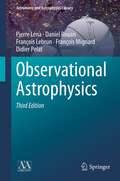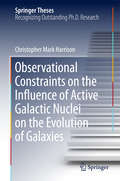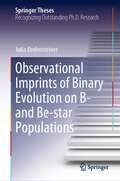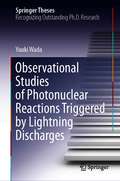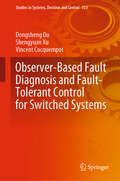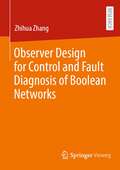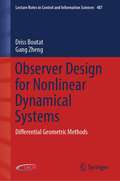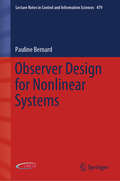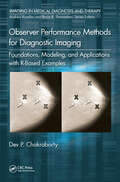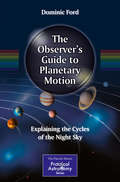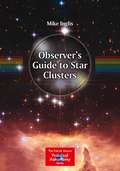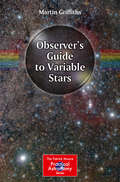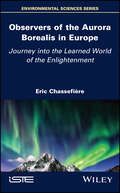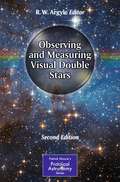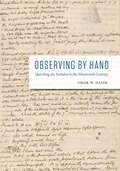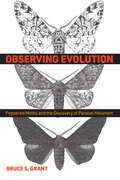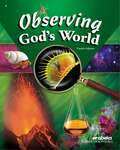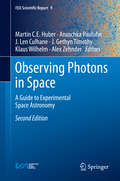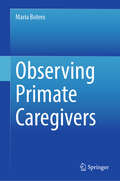- Table View
- List View
Observational Astrophysics
by Daniel Rouan Didier Pelat François Lebrun François Mignard Laurent Mugnier Pierre Léna Stephen Lyle,This is the updated, widely revised, restructured and expanded third edition of Léna et al.'s successful work Observational Astrophysics. It presents a synthesis on tools and methods of observational astrophysics of the early 21st century. Written specifically for astrophysicists and graduate students, this textbook focuses on fundamental and sometimes practical limitations on the ultimate performance that an astronomical system may reach, rather than presenting particular systems in detail. In little more than a decade there has been extraordinary progress in imaging and detection technologies, in the fields of adaptive optics, optical interferometry, in the sub-millimetre waveband, observation of neutrinos, discovery of exoplanets, to name but a few examples. The work deals with ground-based and space-based astronomy and their respective fields. And it also presents the ambitious concepts behind space missions aimed for the next decades. Avoiding particulars, it covers the whole of the electromagnetic spectrum, and provides an introduction to the new forms of astronomy becoming possible with gravitational waves and neutrinos. It also treats numerical aspects of observational astrophysics: signal processing, astronomical databases and virtual observatories.
Observational Constraints on the Influence of Active Galactic Nuclei on the Evolution of Galaxies
by Christopher Mark HarrisonThis prize-winning Ph. D. thesis by Chris Harrison adopts a multi-faceted approach to address the lack of decisive observational evidence, utilising large observational data sets from several world-leading telescopes. Developing several novel observational techniques, Harrison demonstrated that energetic winds driven by Active Galactic Nuclei (AGN) are found in a large number of galaxies, with properties in agreement with model predictions. One of the key unsolved problems in astrophysics is understanding the influence of AGN, the sites of growing supermassive black holes, on the evolution of galaxies. Leading theoretical models predict that AGN drive energetic winds into galaxies, regulating the formation of stars. However, until now, we have lacked the decisive observational evidence to confirm or refute these key predictions. Careful selection of targets allowed Harrison, to reliably place these detailed observations into the context of the overall galaxy population. However, in disagreement with the model predictions, Harrison showed that AGN have little global effect on star formation in galaxies. Theoretical models are now left with the challenge of explaining these results.
Observational Imprints of Binary Evolution on B- and Be-star Populations (Springer Theses)
by Julia BodensteinerThis book presents novel observational evidence toward detecting and characterizing the products of massive, interacting binary stars. As a majority of massive stars are born in close binary systems, a large number of so-called massive binary interaction products are predicted to exist; however, few have been identified so far. Based on observations with the largest telescopes around the world, equipped with state-of-the-art instrumentation, this book helps to remedy this situation. In her outstanding PhD-thesis Julia Bodensteiner identifies a new class of post-interaction binaries in a short-lived phase just briefly after the initially more massive star has been stripped of part of its envelope. She further provides new evidence for the Be phenomenon to largely result from binary interactions. These results represented a new and testable prediction for the evolution of these stars and opened up a new way forward for identifying hundreds of post-interaction products.Finally, using the MUSE integral field spectrograph at the Very Large Telescope in Chile, the author presents a novel spectroscopic campaign focusing on the 40 Myr-old star cluster NGC 330 in the Small Magellanic Clouds. Combined with photometric observations from the Hubble Space Telescope, the MUSE data allow to characterize the entire massive star population of NGC 330, revealing their multiplicity properties and rotational velocities and providing unique observational constraints on their (binary) evolution history. This is made possible by the developments of novel numerical methods allowing to extract star spectra from the MUSE integral field spectroscopic data and to characterize their properties by the simultaneous comparison of MUSE spectroscopy and Hubble photometry with atmospheric models.This book is a partly re-written version of the author's thesis offering a highly readable coherent text presenting not only new insights into the properties of binary interaction products but also giving students an excellent introduction into the field.
Observational Molecular Astronomy: Exploring the Universe Using Molecular Line Emissions
by David A. Williams Serena VitiMolecular line emissions offer researchers exciting opportunities to learn about the evolutionary state of the Milky Way and distant galaxies. This text provides a detailed introduction to molecular astrophysics and an array of useful techniques for observing astronomical phenomena at millimetre and submillimetre wavelengths. After discussing the theoretical underpinnings of molecular observation, the authors catalogue suitable molecular tracers for many types of astronomical regions in local and distant parts of the Universe, including cold gas reservoirs primed for the formation of new stars, regions of active star formation, giant photon-dominated regions and near active galactic nuclei. Further chapters demonstrate how to obtain useful astronomical information from raw telescope data while providing recommendations for appropriate observing strategies. Replete with maps, charts and references for further reading, this handbook will suit research astronomers and graduate students interested in broadening their skill to take advantage of the new facilities now coming online.
Observational Studies of Photonuclear Reactions Triggered by Lightning Discharges (Springer Theses)
by Yuuki WadaThis book presents the first simultaneous detection of neutrons and positrons after a terrestrial gamma-ray flash (TGF), a highest-energy transient phenomenon on the earth, triggered by a lightning discharge, based on innovative ground-based observations made in the Hokuriku area of Japan. TGFs, known to be produced by lightning discharges since the 1990s, has been theoretically predicted to react with atmospheric nuclei via photonuclear reactions because they comprise high-energy photons of more than 10 MeV, but such photonuclear reactions by lightning discharges, which produce neutrons and unstable isotopes emitting positrons, were not observationally confirmed. The reactions and propagations of their products in the atmosphere are modeled with Monte Carlo simulations to quantitatively evaluate observations of TGFs, neutrons, and positrons at ground level. The successful comparison between observation and simulation is presented, and demonstrates that lightning discharges to trigger photonuclear reactions and to even produce isotopes in the atmosphere.
Observations on the President's Fiscal Year 1999 Federal Science and Technology Budget
by Committee on Science Engineering Public PolicyA report on Observations on the President's Fiscal Year 1999 Federal Science and Technology Budget
Observatories and Telescopes of Modern Times
by David LeveringtonThis volume gives an historical overview of the development of professional optical and radio observatories from 1945 to today. It covers the environment in which these facilities were developed by organisations in the United States, Europe and elsewhere, often led by larger-than-life individuals, as well as exploring the financial and political factors that both constrained and encouraged progress. As ever more expensive optical facilities were built, they exploited new technologies to significantly improve their performance: CCDs, active and adaptive optics, and spun honeycomb and segmented mirrors. The second half of this volume turns to the parallel history of radio astronomy facilities throughout the world, finishing with the ALMA observatory in Chile. This is the ground-based companion to the author's previous work on space astronomy, New Cosmic Horizons (2001). It is written for both technical and non-technical readers interested in the modern history of astronomy and its observational facilities.
Observer-Based Fault Diagnosis and Fault-Tolerant Control for Switched Systems (Studies in Systems, Decision and Control #323)
by Dongsheng Du Shengyuan Xu Vincent CocquempotThis book focuses on the fault diagnosis observer design for the switched system. Model-based fault diagnosis and fault tolerant control are one of the most popular research directions in recent decades. It contains eight chapters. Every chapter is independent in the method of observer design, but all chapters are around the same topic. Besides, in each chapter, the model description and theoretical results are firstly provided, then some practical application examples are illustrated to prove the obtained results. The advanced theoretical methodologies will benefit researchers or engineers in the area of safety engineering and the arrangement of the structure will help the readers to understand the content easily.
Observer Design for Control and Fault Diagnosis of Boolean Networks
by Zhihua ZhangBoolean control networks (BCNs) are a kind of parameter-free model, which can be used to approximate the qualitative behavior of biological systems. After converting into a model similar to the standard discrete-time state-space model, control-theoretic problems of BCNs can be studied. In control theory, state observers can provide state estimation for any other applications. Reconstructibility condition is necessary for the existence of state observers. In this thesis explicit and recursive methods have been developed for reconstructibility analysis. Then, an approach to design Luenberger-like observer has been proposed, which works in a two-step process (i.e. predict and update). If a BCN is reconstructible, then an accurate state estimate can be provided by the observer no later than the minimal reconstructibility index. For a wide range of applications the approach has been extended to enable design of unknown input observer, distributed observers and reduced-order observer. The performance of the observers has been evaluated thoroughly. Furthermore, methods for output tracking control and fault diagnosis of BCNs have been developed. Finally, the developed schemes are tested with numerical examples.
Observer Design for Nonlinear Dynamical Systems: Differential Geometric Methods (Lecture Notes in Control and Information Sciences #487)
by Driss Boutat Gang ZhengThis book presents a differential geometric method for designing nonlinear observers for multiple types of nonlinear systems, including single and multiple outputs, fully and partially observable systems, and regular and singular dynamical systems. It is an exposition of achievements in nonlinear observer normal forms. The book begins by discussing linear systems, introducing the concept of observability and observer design, and then explains the difficulty of those problems for nonlinear systems. After providing foundational information on the differential geometric method, the text shows how to use the method to address observer design problems. It presents methods for a variety of systems. The authors employ worked examples to illustrate the ideas presented. Observer Design for Nonlinear Dynamical Systems will be of interest to researchers, graduate students, and industrial professionals working with control of mechanical and dynamical systems.
Observer Design for Nonlinear Systems (Lecture Notes in Control and Information Sciences #479)
by Pauline BernardObserver Design for Nonlinear Systems deals with the design of observers for the large class of nonlinear continuous-time models. It contains a unified overview of a broad range of general designs, including the most recent results and their proofs, such as the homogeneous and nonlinear Luenberger design techniques. The book starts from the observation that most observer designs consist in looking for a reversible change of coordinates transforming the expression of the system dynamics into some specific structures, called normal forms, for which an observer is known. Therefore, the problem of observer design is broken down into three sub-problems: • What are the available normal forms and their associated observers?• Under which conditions can a system be transformed into one of these forms and through which transformation? • How can an inverse transformation that recovers an estimate in the given initial coordinates be achieved? This organisation allows the book to structure results within a united framework, highlighting the importance of the choice of the observer coordinates for nonlinear systems. In particular, the first part covers state-affine forms with their Luenberger or Kalman designs, and triangular forms with their homogeneous high-gain designs. The second part addresses the transformation into linear forms through linearization by output injection or in the context of a nonlinear Luenberger design, and into triangular forms under the well-known uniform and differential observability assumptions. Finally, the third part presents some recently developed methods for avoiding the numerically challenging inversion of the transformation. Observer Design for Nonlinear Systems addresses students and researchers looking for an introduction to or an overview of the state of the art in observer design for nonlinear continuous-time dynamical systems. The book gathers the most important results focusing on a large and diffuse literature on general observer designs with global convergence, and is a valuable source of information for academics and practitioners.
Observer Performance Methods for Diagnostic Imaging: Foundations, Modeling, and Applications with R-Based Examples (Imaging in Medical Diagnosis and Therapy)
by Dev P. Chakraborty"This book presents the technology evaluation methodology from the point of view of radiological physics and contrasts the purely physical evaluation of image quality with the determination of diagnostic outcome through the study of observer performance. The reader is taken through the arguments with concrete examples illustrated by code in R, an open source statistical language." – from the Foreword by Prof. Harold L. Kundel, Department of Radiology, Perelman School of Medicine, University of Pennsylvania "This book will benefit individuals interested in observer performance evaluations in diagnostic medical imaging and provide additional insights to those that have worked in the field for many years."– Prof. Gary T. Barnes, Department of Radiology, University of Alabama at Birmingham This book provides a complete introductory overview of this growing field and its applications in medical imaging, utilizing worked examples and exercises to demystify statistics for readers of any background. It includes a tutorial on the use of the open source, widely used R software, as well as basic statistical background, before addressing localization tasks common in medical imaging. The coverage includes a discussion of study design basics and the use of the techniques in imaging system optimization, memory effects in clinical interpretations, predictions of clinical task performance, alternatives to ROC analysis, and non-medical applications. Dev P. Chakraborty, PhD, is a clinical diagnostic imaging physicist, certified by the American Board of Radiology in Diagnostic Radiological Physics and Medical Nuclear Physics. He has held faculty positions at the University of Alabama at Birmingham, University of Pennsylvania, and most recently at the University of Pittsburgh.
The Observer's Guide to Planetary Motion
by Dominic FordTo the naked eye, the most evident defining feature of the planets is their motion across the night sky. It was this motion that allowed ancient civilizations to single them out as different from fixed stars. "The Observer's Guide to Planetary Motion" takes each planet and its moons (if it has them) in turn and describes how the geometry of the Solar System gives rise to its observed motions. Although the motions of the planets may be described as simple elliptical orbits around the Sun, we have to observe them from a particular vantage point: the Earth, which spins daily on its axis and circles around the Sun each year. The motions of the planets as observed relative to this spinning observatory take on more complicated patterns. Periodically, objects become prominent in the night sky for a few weeks or months, while at other times they pass too close to the Sun to be observed. "The Observer's Guide to Planetary Motion" provides accurate tables of the best time for observing each planet, together with other notable events in their orbits, helping amateur astronomers plan when and what to observe. Uniquely each of the chapters includes extensive explanatory text, relating the events listed to the physical geometry of the Solar System. Along the way, many questions are answered: Why does Mars take over two years between apparitions (the times when it is visible from Earth) in the night sky, while Uranus and Neptune take almost exactly a year? Why do planets appear higher in the night sky when they're visible in the winter months? Why do Saturn's rings appear to open and close every 15 years? This book places seemingly disparate astronomical events into an understandable three-dimensional structure, enabling an appreciation that, for example, very good apparitions of Mars come around roughly every 15 years and that those in 2018 and 2035 will be nearly as good as that seen in 2003. Events are listed for the time period 2010-2030 and in the case of rarer events (such as eclipses and apparitions of Mars) even longer time periods are covered. A short closing chapter describes the seasonal appearance of deep sky objects, which follow an annual cycle as a result of Earth's orbital motion around the Sun.
Observer’s Guide to Star Clusters
by Mike InglisAmateur astronomers of all expertise from beginner to experienced will find this a thorough star cluster atlas perfect for easy use at the telescope or through binoculars. It enables practical observers to locate the approximate positions of objects in the sky, organized by constellation. This book was specifically designed as an atlas and written for easy use in field conditions. The maps are in black-and-white so that they can be read by the light of a red LED observer's reading light. The clusters and their names/numbers are printed in bold black, against a "grayed-out" background of stars and constellation figures. To be used as a self-contained reference, the book provides the reader with detailed and up-to-date coverage of objects visible with small-, medium-, and large-aperture telescopes, and is equally useful for simple and computer-controlled telescopes. In practice, GO-TO telescopes can usually locate clusters accurately enough to be seen in a low-magnification eyepiece, but this of course first requires that the observer knows what is visible in the sky at a given time and from a given location, so as to input a locatable object. This is where "The Observer's Guide to Star Clusters" steps in as an essential aid to finding star clusters to observe and an essential piece of equipment for all amateur astronomers.
Observer's Guide to Variable Stars (The Patrick Moore Practical Astronomy Series)
by Martin GriffithsThis book contains everything you need to know about variable stars -- stars whose brightness varies noticeably over time. The study of variable stars has been a particularly popular area of research for amateurs for many years; the material contained herein serves as both an introduction to amateur astronomers and a useful reference source for seasoned variable star observers. With its thorough, non-mathematical descriptions of variable stars and tips for how to see them, this book enables novices and experts alike to set off into the field and observe a wide range of delightful sights. It strikes a balance between easily visible objects that can be seen in any telescope or binoculars, and variable stars that are a direct challenge to those with large aperture equipment or access to photometric tools and methods.After helping the observer differentiate between variable star types, the author goes on to explain the skills needed to operate a telescope and other equipment, as well as how to couple filters to a CCD camera or digital SLR camera in order to photometrically record these celestial objects. Further, the book includes an observational guide to 50 objects for study, with finder charts and data about light curves for ease of identification, along with the stars’ celestial coordinates, magnitudes, and other pertinent information.
Observers of the Aurora Borealis in Europe: Journey into the Learned World of the Enlightenment
by Eric ChassefiereThe spectacular reappearance of the aurora borealis at the beginning of the 18th century, often observed simultaneously from different observatories in Europe, mobilized and federated a large community of astronomers on a European scale. It encouraged them to communicate the results of their observations and, in compiling exhaustive catalogs of information, has helped to establish a system of the aurora borealis that can be further studied in the future, according to the experimental method inherited from the previous century. This book is dedicated to some of the main aurora observers in Europe and to the human, institutional and philosophical context in which they evolved in the first half of the 18th century. Its reading should be seen as a retrospective journey through the scholarly world of the Enlightenment, during which the same scholars are frequently encountered and reencountered, yet each time in different contexts, or from different angles, with the aim of compiling an account of the swarming of ideas and encounters that constituted the development of experimental science in this pivotal period.
Observing and Measuring Visual Double Stars
by R. W. ArgyleThe second edition of Observing and Measuring Visual Double Stars (2004) is the definitive book for those who are serious about this fascinating aspect of astronomy. It deals with equipment (you can start modestly with commercial or even home-made instruments), observing methods using binoculars upwards to advanced instrumentation and techniques, including speckle interferometry. The astronomy of double stars, including orbital calculation, is given its own section. This second edition of this popular book contains a significant amount of completely new material, inspired by the work done by observers - particularly in the USA - since the first edition was published. This includes the use of the Internet to carry out astrometry (precise astronomical measurement) using existing survey plates and films. The new edition contains an excellent guide to sketching double stars, a topic not previously covered. In addition, there is information about how to image double stars of unequal brightness, always a difficult matter but now somewhat easier because of advances in hardware and image-processing software. Nearly all of the chapters and tables have been updated. The CD-ROM that accompanied the first edition of Observing and Measuring Visual Double Stars is replaced by access to the Springer Extras web site. The extra information includes the complete Washington Double Star and Tycho-2 Catalogs. There is an extensive database of astrometric, double-and multiple-star formation, including positions, orbits, separations, and magnitudes, and a software suite that implements many of the calculations and equations featured in the book.
Observing by Hand: Sketching the Nebulae in the Nineteenth Century
by Omar W. NasimToday we are all familiar with the iconic pictures of the nebulae produced by the Hubble Space TelescopeOCOs digital cameras. But there was a time, before the successful application of photography to the heavens, in which scientists had to rely on handmade drawings of these mysterious phenomena. aaaaaaaaaaa"Observing by Hand" sheds entirely new light on the ways in which the production and reception of handdrawn images of the nebulae in the nineteenth century contributed to astronomical observation. Omar W. Nasim investigates hundreds of unpublished observing books and paper records from six nineteenth-century observers of the nebulae: Sir John Herschel; William Parsons, the third Earl of Rosse; William Lassell; Ebenezer Porter Mason; Ernst Wilhelm Leberecht Tempel; and George Phillips Bond. Nasim focuses on the ways in which these observers created and employed their drawings in data-driven procedures, from their choices of artistic materials and techniques to their practices and scientific observation. He examines the ways in which the act of drawing complemented the acts of seeing and knowing, as well as the ways that making pictures was connected to the production of scientific knowledge. aaaaaaaaaaaAn impeccably researched, carefully crafted, and beautifully illustrated piece of historical work, "Observing by Hand "will delight historians of science, art, and the book, as well as astronomers and philosophers. "
Observing Evolution: Peppered Moths and the Discovery of Parallel Melanism
by Bruce S. GrantA firsthand account of how a modest moth demonstrated Darwin's theory of natural selection.The extraordinary tale of the humble peppered moth is at the very foundation of our acceptance of Darwinian evolution. When scientists in the early twentieth century discovered that a British population of the small, speckled Biston betularia had become black over the course of mere decades in response to the Industrial Revolution's encroaching soot, the revelation cemented Darwin's theory of natural selection. This finding was the staple example of "evolution in action" until the turn of the millennium, when proponents of Creationism fomented doubts about the legitimacy of early experiments. In the midst of this upheaval, evolutionary biologist Bruce S. Grant and his contemporaries were determinedly building a dataset that would ultimately vindicate the theory of industrial melanism in the peppered moth and, by extension, the theory of natural selection itself. Observing Evolution tells the remarkable story of this work. Shining a light on the efforts of scientists who tested Darwin's trailblazing theory, Grant chronicles the historical foundations of peppered moth research, then explains how he and his collaborators were able to push this famous study forward. He describes how his experiments were designed and conducted while painting a vivid picture of the personalities, events, and adventures around the world that shaped his successes—and struggles. His story culminates with his discovery of the mirrored "rise and fall" of melanism in peppered moth populations separated by the vastness of the Atlantic Ocean, which settled the intense controversy around evolution by documenting nature's recurring experiment. Observing Evolution is a crash course in natural selection and the history of evolutionary biology for anyone interested in Darwin's legacy. It's also a fascinating read for lepidopterists and scientists about the bridge between classic experiments and today's sophisticated DNA sequencing, which reveals in ever greater detail how the lives of these tiny organisms have such enormous implications.
Observing God's World
by Abeka BooksObserving God's World, is a Science by Abeka, for homeschooling, or schools to use for 6th grade studies.
Observing God's World (4th Ed.)
by Gregory Rickard Gregory ParkerA textbook designed to train children and young people in the Christian way of life.
Observing Nebulae
by Martin GriffithsThis book enables anyone with suitable instruments to undertake an examination of nebulae and see or photograph them in detail. Nebulae, ethereal clouds of gas and dust, are among the most beautiful objects to view in the night sky. These star-forming regions are a common target for observers and photographers. Griffiths describes many of the brightest and best nebulae and includes some challenges for the more experienced observer. Readers learn the many interesting astrophysical properties of these clouds, which are an important subject of study in astronomy and astrobiology. Non-mathematical in approach, the text is easily accessible to anyone with an interest in the subject. A special feature is the inclusion of an observational guide to 70 objects personally observed or imaged by the author. The guide also includes photographs of each object for ease of identification along with their celestial coordinates, magnitudes and other pertinent information. Observing Nebulae provides a ready resource to allow anyone with a little experience in astronomy, whether professional or amateur, to locate, identify and record the nebulae in our home galaxy. The author enables the observer to use a telescope and filters to the best advantage to see these celestial wonders, or to couple filters to a CCD camera or digital SLR camera in order to take quality images of celestial objects. By using these techniques it is even possible to make a valid contribution to professional investigations. And the views are unbeatable.
Observing Photons in Space
by Martin C. E. Huber Anuschka Pauluhn J. Len Culhane J. Gethyn Timothy Klaus Wilhelm Alex ZehnderAn ideal resource for lecturers, this book provides a comprehensive review of experimental space astronomy. The number of astronomers whose knowledge and interest is concentrated on interpreting observations has grown substantially in the past decades; yet, the number of scientists who are familiar with and capable of dealing with instrumentation has dwindled. All of the authors of this work are leading and experienced experts and practitioners who have designed, built, tested, calibrated, launched and operated advanced observing equipment for space astronomy. This book also contains concise information on the history of the field, supported by appropriate references. Moreover, scientists working in other fields will be able to get a quick overview of the salient issues of observing photons in any one of the various energy, wavelength and frequency ranges accessible in space. This book was written with the intention to make it accessible to advanced undergraduate and graduate students.
Observing Primate Caregivers
by Maria BoteroThis book aims to advance our understanding of the caregiver-infant interaction in primates and its effect on the development of social cognition, working from an interdisciplinary approach (i.e., psychology, philosophy, and anthropology), challenging the dominant cognitivist perspectives and methodologies. This book is important because it contributes to understanding how primate parent-and-infant interaction works and how it affects the infant’s development. Understanding this parent-and-infant interaction contributes to finding better ways to support human parents and provide better care for non-human primate mothers and infants in captivity.
